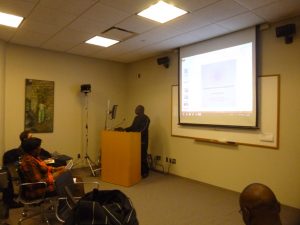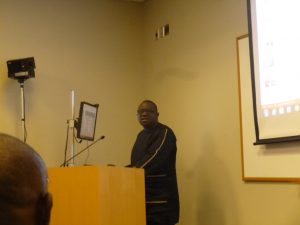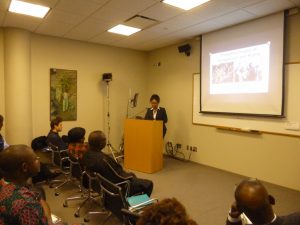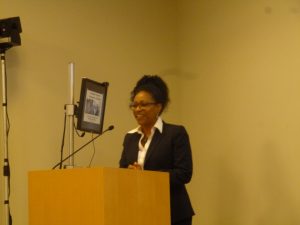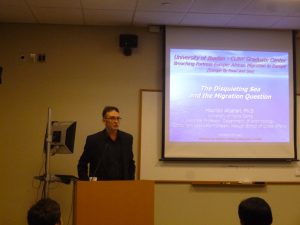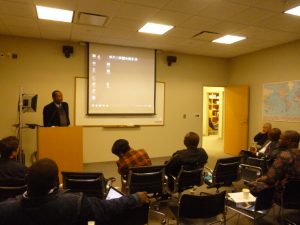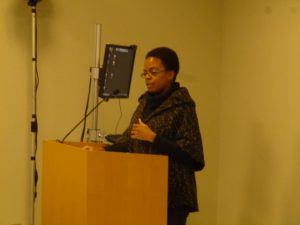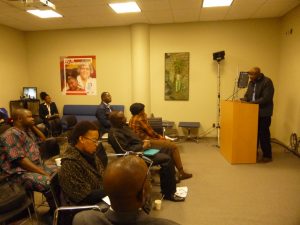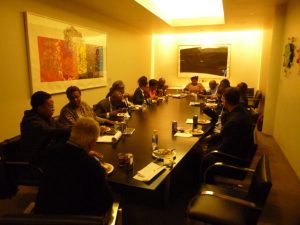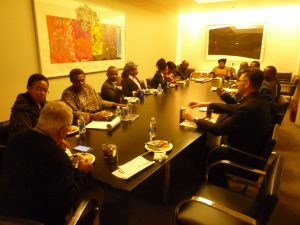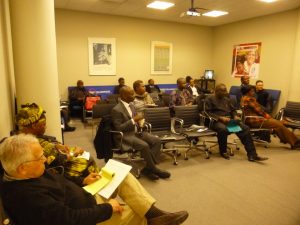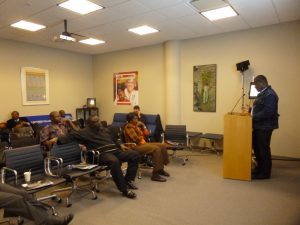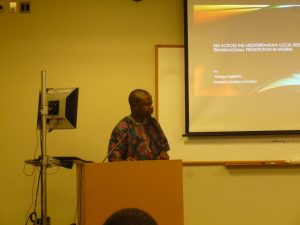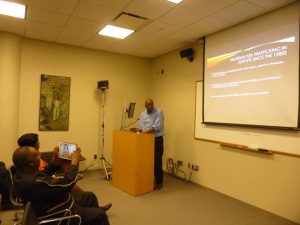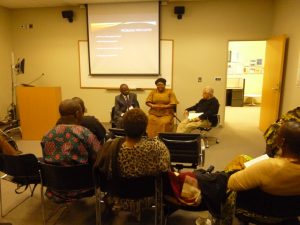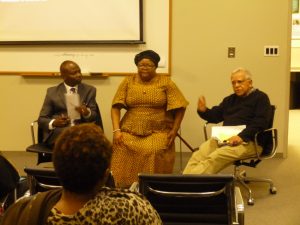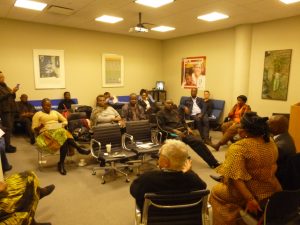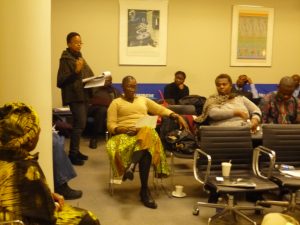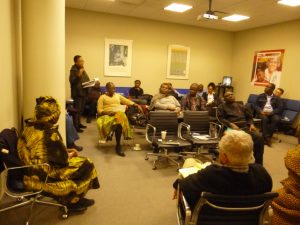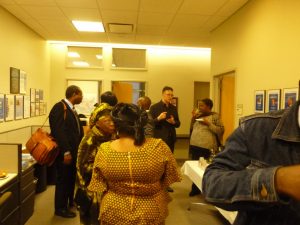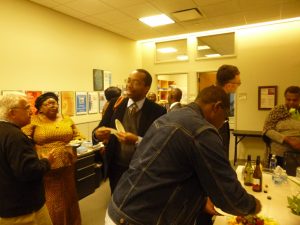Dr. Marnia Lazreg is a professor of Sociology at Hunter College. Raised in Algeria, she received her Baccalaureate in Mathematics and Philosophy and a licence-ès-lettres from the University of Algiers and received her Ph.D. in Sociology from New York University. She is the author of several books, including The Emergence of Classes in Algeria: A Study of Colonialism and Socio-Political Change (1976), The Eloquence of Silence: Algerian Women in Question (1996), Torture and the Twilight of Empire: From Algiers to Baghdad (2008), and Questioning the Veil: Open Letters to Muslim Women (2010). She has also recently completed a manuscript about Michel Foucault’s struggles with how to theorize cultural difference.
In her talk at the Advanced Research Collaborative, “Gendered Pathways to Culturalism and Cosmopolitanism on the Islamic Periphery,” Dr. Lazreg shared her ongoing research, which explores contemporary examples of what she calls “de-centered universalism” and “practice-oriented cosmopolitanism” in Iran and Algeria. Drawing inspiration from Immanuel Kant’s definition of cosmopolitanism as knowledge of man as a “citizen of the world,” she grounds her theoretical discussion in relation to several specific case studies — the anti-fracking movement in the oil-rich desert town of In Saleh in Southern Algeria, an anti-veiling campaign sponsored by an Algerian Sufi order, Iranian Islamic scholars’ efforts to read and rethink Western cosmopolitan thought, and cases of Islamic feminism.
The title of her talk refers to two intellectual traditions: Euro-American literature on cosmopolitan studies, on one hand, and scholarship on unequal exchange between countries of the “center” and those of the “periphery” under global capitalism, on the other. She argues that the trend toward “decentered cosmopolitanism” in Iran and Algeria poses a challenge to the unequal exchange of ideas by “de-localizing Western thought and practices while redrawing the intellectual boundaries of local as well as Western cultures.” In this context, her endeavor is to develop a comparative transnational and transcultural analytical framework focused on how regions on the “periphery” engage in cosmopolitan practices and ideas in times of crisis. In doing so, she aims to reframe some of the central questions in debates on cosmopolitanism and multiculturalism: Are cultures incommensurable? Is cosmopolitanism Eurocentric?
The conceptual background of Dr. Lazreg’s talk covered three main bodies of literature which each deal differently with what she calls the “conundrum of cultural difference”: cosmopolitan studies and debates on multiculturalism, Ulrich Beck’s critique of sociological theory, and anthropological approaches of “local knowledge” (idealized knowledge from the periphery). She finds fruitful the well-known debate between Nancy Fraser and Axel Honneth focusing on the relationship between movements aimed at the recognition of cultural rights and those centered on the pursuit of redistributive justice, but finds that the debate still obviates the central question of cultural difference. She argues that Seyla Benhabib’s question about whether universalism is Eurocentric is also problematic in its implicit assumption that cosmopolitanism, by definition, is theorized only in Western contexts. In contrast, she finds more useful Ulrich Beck’s concept of “second stage modernity” which foregrounds “risk” as a ubiquitous feature of late-modern social existence, in which “relations of definition” (analogous to Marx’s relations of production) are a defining factor in the unequal production and valuation of cultural difference. Finally, Dr. Lazreg praises the trend among anthropologists who seek to turn to knowledge produced by countries of the periphery in an attempt to rejuvenate their theories, from Levi-Strauss to Jean and John Comaroff. However, in “going south,” Dr. Lazreg argues, such anthropologists do not necessarily ask whether the theories of “local knowledge” they are adopting actually work for the people they are studying. Building from her critical engagement with this literature, she suggests an exploration instead of what she calls “de-centered universalism,” through which she aims to develop a non-reified conception of cultural difference. She asks: “How do non-Western peoples in the present historical conjuncture read and mark the very systems of knowledge that are being either questioned or broadened at the center?”
Segueing from this theoretical discussion, Dr. Lazreg presented two different cases in Algeria as examples of “practice-oriented cosmopolitanism.” She began with the anti-fracking movement in the Southern Algerian town of In Saleh that began in January 2015 in response to the Algerian government’s plans to begin exploratory drilling for shale oil. In Saleh is a town of 32,000 in the heart of Algeria’s oil and gas region, which is dominated by multinational oil corporations. Dr. Lazreg argued that the protests were a culmination of grievances against Algerian state policies which exploit the South as a resource for energy export, but which systematically neglect the socioeconomic needs of the population. Water is a scarce resource in this extremely arid region, and local residents depend on non-renewable groundwater resources for their livelihoods. Recognizing that fracking poses a threat to the ecological sustainability of their region, In Saleh residents gathered in the town square which they called Sahat as-sumud (resistance square), echoing the famous Tahrir square in Cairo, demanding an immediate halt to shale oil exploitation. Nearby cities staged solidarity protests with In Saleh residents, eventually attracting international solidarity.
According to Dr. Lazreg, the In Saleh anti-fracking movement has had more enduring power than almost any other movement since the Algerian civil war from 1992-2002. Further, in contrast to other social movements in the Middle East, protesters did not demand a change of government or single out particular politicians, but instead framed their demands as citizens concerned for the environment. When the Algerian government alleged that protesters were committing a sin by opposing the exploitation of a “God-given” resource, protesters responded with a discourse of civility, attachment to land, and love for water as a shared resource, creatively reorienting the idea “local” cultural patrimony toward a broader planetary cause inclusive of others beyond borders. The protests also became a stage from which to challenge long-standing elitism from North Algeria against the South, epitomized by “Samidoune,” a joint North-South collaboration of Algerian rappers, Lotfi DK and the Desert Boys, expressing solidarity with In Salah.
Dr. Lazreg’s second case of “practice-oriented cosmopolitanism” is an anti-veiling campaign led by a Sufi order in the coastal city of Mostaghanem, Algeria. Much like the anti-fracking movement, this anti-veiling campaign is notably female-led. Dr. Lazreg discussed an exhibition launched by this Sufi order, which subtly calls into question the growing centrality of the veil within Islamist and Islamic feminist discourse, by pointing to its pre-Islamic origins and historicizing the multiple uses of the veil across time and space. In this way, the exhibition shows that the veil is a culturally and historically variable formation, not an immutable tradition. Though Dr. Lazreg avers that the anti-veiling campaign is more symbolic than substantive when compared to the anti-fracking movement, she draws parallels between the two as acts “blurring custom and faith” – water and faith, on one hand, and veil and faith, on the other.
Finally, Dr. Lazreg moved on to discuss intellectual trends in post-1979 revolution Iran as examples of “reframing universal thought.” Over the past three decades, a range of Islamic philosophers in Iran have sought to engage with Euro-American Enlightenment philosophy through interpretation, translation, and inviting Western scholars to lecture in Iran. Her discussion focused on Abdolkarim Soroush, a prominent contemporary Islamic philosopher who teaches at the University of Tehran. According to Soroush, religious knowledge, though sacred in subject matter, is fallible and ephemeral because it, like any other branch of knowledge, is a product of human understanding. Because of its contextuality, time-boundedness, and relativity to external circumstances, he argues, any form of religious knowledge is subject to expansion and contraction. Soroush, in this sense, is relinking to an earlier hermeneutic tradition in Islam, the mu’tazilah, a school of Islamic theology that emerged in Basra and Baghdad during the 8th–10th centuries. What is interesting for Dr. Lazreg is that Soroush is also reading Kant and Hegel, thus reframing the perceived aporia between Islamic studies and Enlightenment philosophy.
Building upon the topic of cosmopolitanism, Dr. Lazreg also mentioned that Soroush is critical of the cultural nationalism put forth by some Iranian revolutionary thinkers, as well as African liberation thinkers, such as Aime Cesaire and Frantz Fanon. Paraphrasing Dr. Soroush, she asks: does “learning from others (meaning the West) threaten one’s identity?” Challenging essentialist definitions of cultural or national identity, Dr. Lazreg suggests that Soroush’s writings problematize the epistemological premise of a “return” to one’s authentic self, whether in the form of culturalist nationalism, anti-religious nationalism, or fundamentalist religious revisionism. He also broaches the vexing status of “reason” within Islam in Reason, Freedom, and Democracy in Islam. In this context, Dr. Lazreg drew parallels to Kant’s conception of critique and the universalism of human nature.
Ultimately, Dr. Lazreg’s talk demonstrates that serious intellectual engagement with these examples of “practice-oriented cosmopolitanism” and “reframing universal thought” can each inform a notion of the “supra-cultural good,” with converges Ulrich’s cosmopolitan conception of exposing oneself to the risk of decentering the self. One possible limitation regarding Dr. Lazreg’s approach, which she mentioned during the Q&A, is that there is a subtle epistemological split between her approaches to Iran and Algeria – “theory” in one country (Iran) and “practice” in another (Algeria). As the project takes shape, Dr. Lazreg suggested that she will explore ways to bridge this through engagement with more “theory” in the Algerian context, such as the work of French-Algerian-Kabyle scholar Mohammed Arkoun. Notwithstanding such considerations, which will no doubt be resolved with further development, Dr. Lazreg’s work poses a very compelling challenge to the insularity of debates about cosmopolitanism and multiculturalism in the United States and Europe by treating social movements and intellectual traditions in two Muslim-majority countries not merely as an adjunct to Euro-American theorizing, but as producers of theory and practice in their own right.
~ China Sajadian





